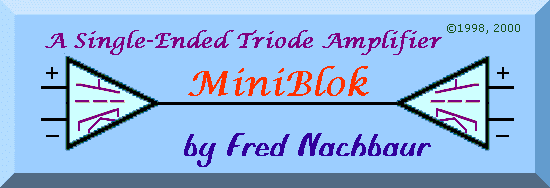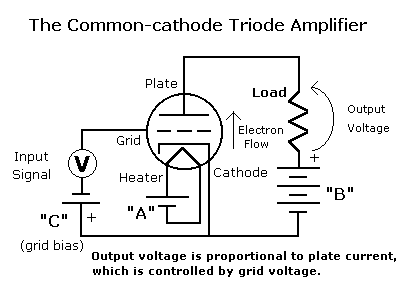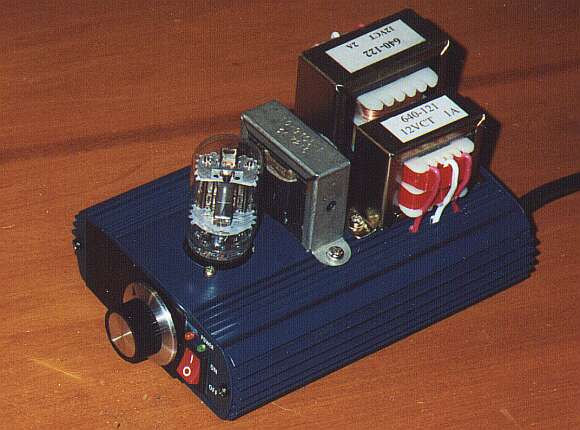A LOW-COST SINGLE-ENDED TRIODE AMPLIFIER
by Fred Nachbaur, Dogstar Music ©2002

Published December, 2002. ©2002 by Fred Nachbaur
1: INTRODUCTION
One of the hottest topics in tube circles is the debate around the Single-Ended Triode
(SET) Amplifier. This extraordinarily simple amplifier topology has a strong following,
with its proponents claiming unsurpassed clarity and realism. The "pro" argument
invariably includes the fact that the vacuum triode is the most inherently linear
amplifying device ever created, and usually claims that the minimum number of parts in the
signal path gives the best results.
On the other side, the SET's detractors point out to the fact that it cannot possibly be
as linear as a push-pull amplifier built using similar components, in which most of the
even-order harmonics are cancelled out by nature of the push-pull topology. Numbers don't
lie, they say, and you can't improve fidelity by increasing distortion.
While I certainly have my own opinions on this subject, (and am happy to share them with
you at the end of the "performance" section)
the purpose of this project is not to try to sway the reader in either direction. Rather,
here is an opportunity for you to explore the possibilities for yourself, at reasonable
cost, and thereby form your own opinions based on direct experience.
This project uses readily available parts, many of which can be scrounged from fairly
well-stocked junk bins. Even if all parts are purchased, it is unlikely that the cost of
parts will exceed $100. Construction is relatively non-critical, and because of the
relatively low supply voltages used, is even comparatively free of electrocution hazard.
That being said, some prior electronics construction experience is recommended, and
personal safety can never be overstressed.
What's a Single-Ended Amplifier?
A single-ended amplifer only has a single device controlling the electron flow that
represents its output. In this case, the device is a vacuum triode. The basic SET
topology is the simple circuit shown below:

The input signal is applied to the tube's grid, which controls the current flowing from
cathode to plate, and therefore through the load, causing a varying voltage across the
load which is much greater than that at the grid. For more information on basic tube
theory, have a look at
this mini-article. (Use your browser's BACK button to return
here when done.)
In addition to its obvious simplicity, the vacuum triode is one of the most linear
amplifying devices known. For this reason, very simple yet euphonious amplifiers can be
built around them, without the need for externally applied negative feedback to try to
remove artifacts introduced by non-linearity. At the other extreme are most solid-state
amplifiers; while transistors are not very linear, it's inexpensive to integrate hundreds
or thousands of them onto a single circuit that incorporates heavy negative feedback to
improve response.
What good is just one watt?
You may be pondering if one watt is enough sound to even hear, let alone enjoy. You may be
used to amplifiers rated at tens or hundreds of watts of output power, and wonder what
kind of lunatic would recommend building an amplifier with an output power of a mere watt!
It's important to remember that the ear responds logarithmically, rather than linearly.
This means that a 100 watt amplifier won't sound 100 times as loud as a one watt amp.
Rather, every doubling (or other multiple) of power will increase the perceived loudness
by the same fixed amount. So, 10 watts will merely sound "somewhat louder" than
one watt. In order to get the same loudness increase above 10 watts, the power would
have to be increased to 100 watts, and so on. Acoustic engineers therefore think in terms
of "decibels", where 10 decibels (dB) represent a ten-times power increase. So
20 dB would be a 100 times increase, 30 dB = 1000 times, and so on.
It's also important to remember that loudspeaker sensitivity plays a vital role in how
much power it takes to obtain a usable sound volume. Typical modern speakers have a
sensitivity of about 90 dB (in other words, they make 90 decibels of sound one meter away,
when driven by one watt of power). Some are quite a bit lower yet, down to around 80 dB
for some of the air-suspension speakers intended for use with high-power solid-state
amps. However, older speaker designs sported sensitivities in excess of 100 dB! Another
way of looking at it is that one watt into a 100 dB speaker will sound exactly as loud as
100 watts into a speaker with an 80 dB sensitivity!







